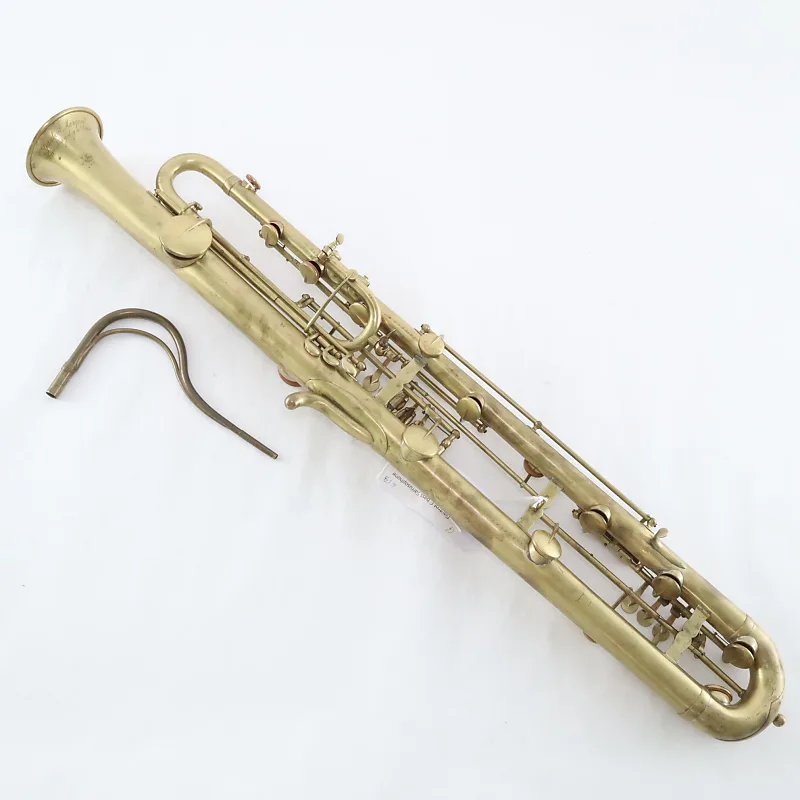Sarrusophone
Woodwinds
Europe
Between 1001 and 1900 AD
Video
The sarrusophone is a unique family of metal double-reed wind instruments that has found its niche primarily in military and concert bands. Known for its powerful sound and distinctive design, the sarrusophone serves as a versatile addition to various musical ensembles.
Description and Purpose
The sarrusophone is characterized by its conical bore and metal construction, typically made from brass or other durable materials. It features a double reed similar to that of the oboe but is designed to produce a louder, more penetrating sound suitable for outdoor performances. The instrument usually has a range of sizes, including soprano, alto, tenor, baritone, bass, and contrabass, each with its unique pitch and tonal qualities. The primary purpose of the sarrusophone is to provide rich melodic lines in military bands and orchestras. It was originally intended to replace the oboe and bassoon in outdoor settings where these instruments lacked the necessary volume. The sarrusophone’s robust sound makes it ideal for leading ensembles during parades, ceremonies, and other public events.
Historical Origin
The sarrusophone was patented and first manufactured by French instrument maker Pierre-Louis Gautrot in 1856. Gautrot named the instrument after Pierre-Auguste Sarrus, a French bandmaster credited with conceptualizing the instrument, although it remains unclear whether Sarrus benefited financially from this invention. The sarrusophone quickly gained popularity in military bands across France, Italy, and Spain.
Throughout the late 19th and early 20th centuries, notable composers such as Paul Dukas, Maurice Ravel, and Igor Stravinsky incorporated the sarrusophone into their works. Despite its initial success, the instrument never achieved widespread acceptance compared to other woodwinds like the saxophone or clarinet. This was partly due to its somewhat harsh tone quality and limited range compared to those instruments.
Working Mechanism
The working mechanism of the sarrusophone involves air being blown into a mouthpiece fitted with a double reed. When air passes through the reed, it vibrates against itself, producing sound waves that resonate through the conical body of the instrument. Players can change pitch by covering or uncovering finger holes along the body. The conical bore design enhances sound amplification, allowing for a wide dynamic range from soft tones to powerful blasts.
Types of Sarrusophones
The sarrusophone family includes several types based on size and pitch:
Soprano Sarrusophone: The highest-pitched variant, often used in concert bands.
Alto Sarrusophone: A mid-range version that provides a balance between treble and bass tones.
Tenor Sarrusophone: Similar to the alto but typically tuned lower.
Baritone Sarrusophone: Offers deeper tones suitable for various musical contexts.
Bass Sarrusophone: Produces very low pitches.
Contrabass Sarrusophone: The largest type capable of producing extremely low sounds.
Each type serves specific roles within musical compositions, allowing for intricate harmonies and melodies.
Features
The sarrusophone is distinguished by several key features:
Typically made from brass or other metals that enhance durability and tonal quality. Known for its loud and bright tone that can project over large ensembles.
Fingering System: The fingering of the sarrusophone is nearly identical to that of the saxophone, making it accessible for players familiar with that instrument.
Cultural Significance: While not as widely used today, the sarrusophone remains an important part of military band repertoire and has historical significance in orchestral music.
The sarrusophone, a family of keyed brass instruments with a double reed, produces a sound that blends characteristics of woodwinds and brass. Its tone is reedy and rich, similar to a bassoon or contrabassoon, but with a brassier, more resonant quality due to its metal construction. This unique timbre makes it well-suited for military bands, orchestral music, and opera, particularly in low-register parts requiring depth and projection. It can also handle various musical styles, ranging from solemn, resonant passages in classical compositions to vibrant, rhythmic roles in marches and ceremonial music. While it was initially developed to replace bassoons in outdoor military bands, it has also been used by composers seeking a distinctive tone in orchestral works. Its sound is often described as powerful and sonorous, yet flexible enough for melodic and harmonic roles.
The sarrusophone is a fascinating instrument with a rich history and distinct characteristics. Although it never achieved mainstream popularity like some of its woodwind counterparts, its unique sound and versatility ensure its continued relevance in specific musical contexts today.
FAQ
How is the Sarrusophone Constructed?
The Sarrusophone is constructed from brass or other metals and features a conical bore that allows for a powerful sound. It has several finger holes similar to those of the saxophone, making it easier for players familiar with that instrument to transition. The double reed is mounted on a metal mouthpiece, contributing to its distinctive tone that is both reedy and penetrating.
What is the Sarrusophone and its Historical Background?
The Sarrusophone is a family of metal double-reed instruments that were patented by French instrument maker Pierre-Louis Gautrot in 1856. It was designed to replace oboes and bassoons in military bands, providing a louder sound suitable for outdoor performances. Named after the French bandmaster Pierre-Auguste Sarrus, the instrument has a conical bore and is available in various sizes, including soprano, alto, tenor, and contrabass.
What Role Does the Sarrusophone Play in Modern Music?
In modern music, the Sarrusophone is primarily used in military bands, orchestras, and some contemporary compositions. While it has not achieved widespread popularity compared to other woodwinds like the saxophone or bassoon, it has been featured in works by composers such as Igor Stravinsky and Maurice Ravel. Its unique sound can add depth to musical arrangements, particularly in outdoor settings.
 Links
Links
References
Other Instrument
Categories


















